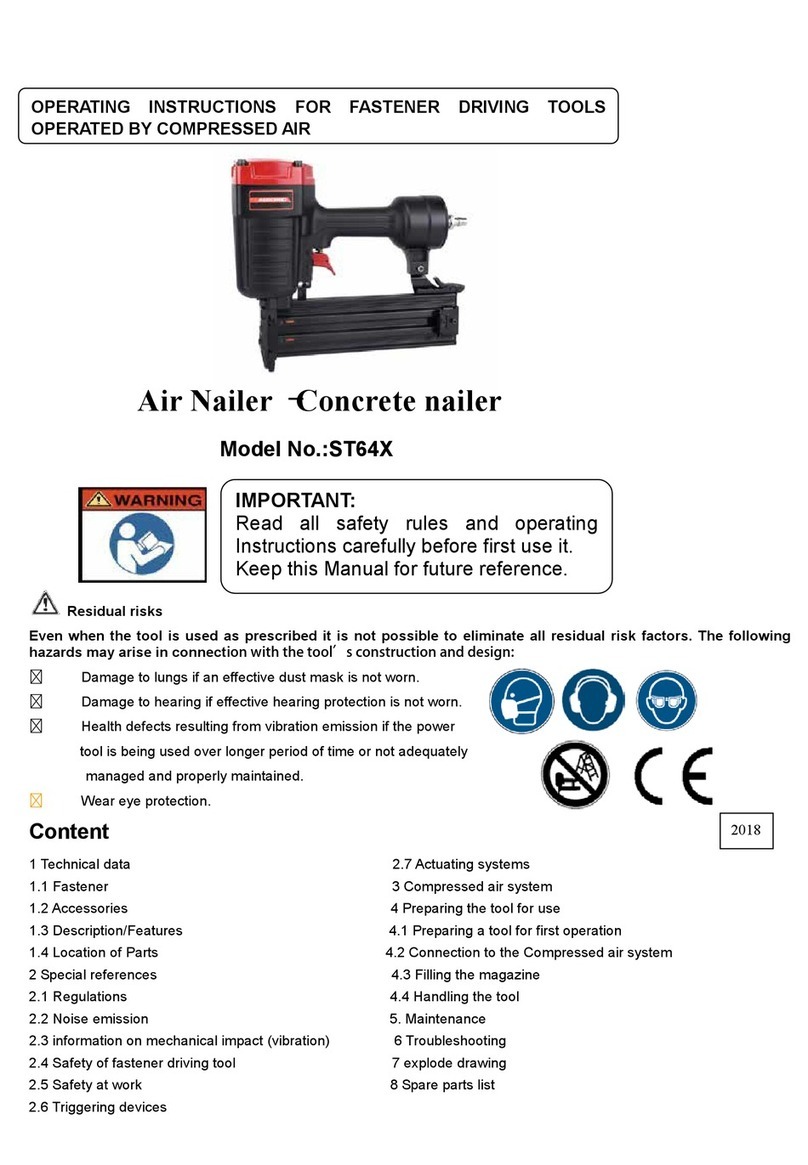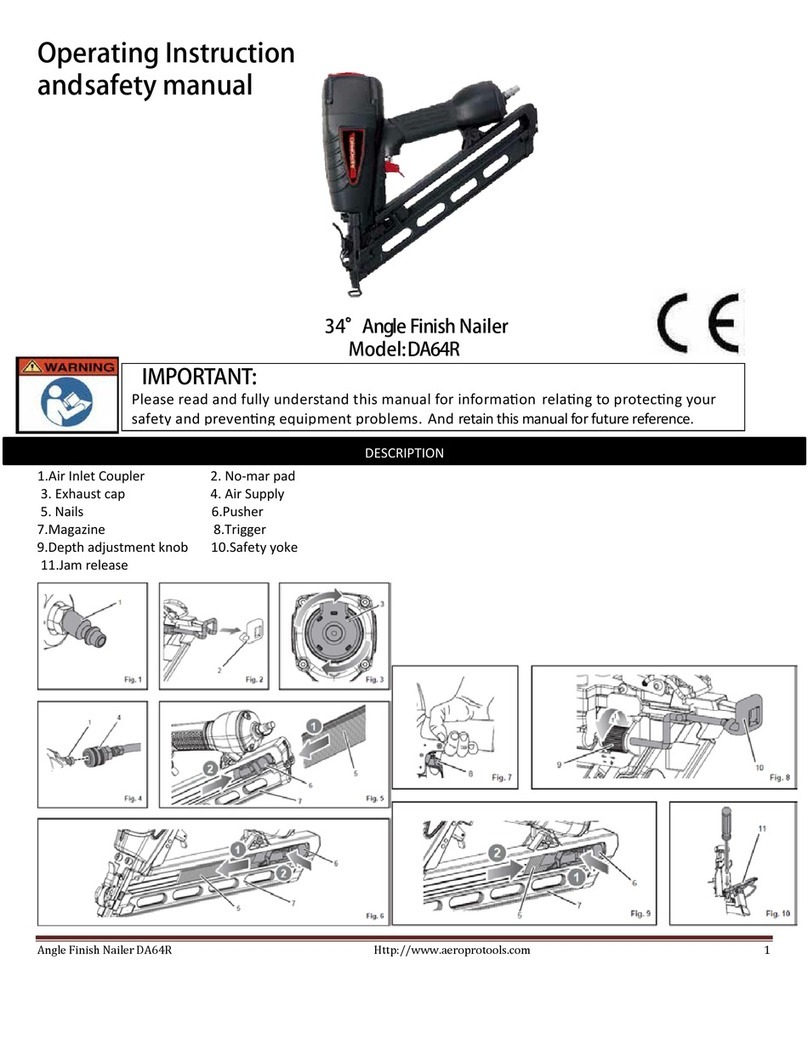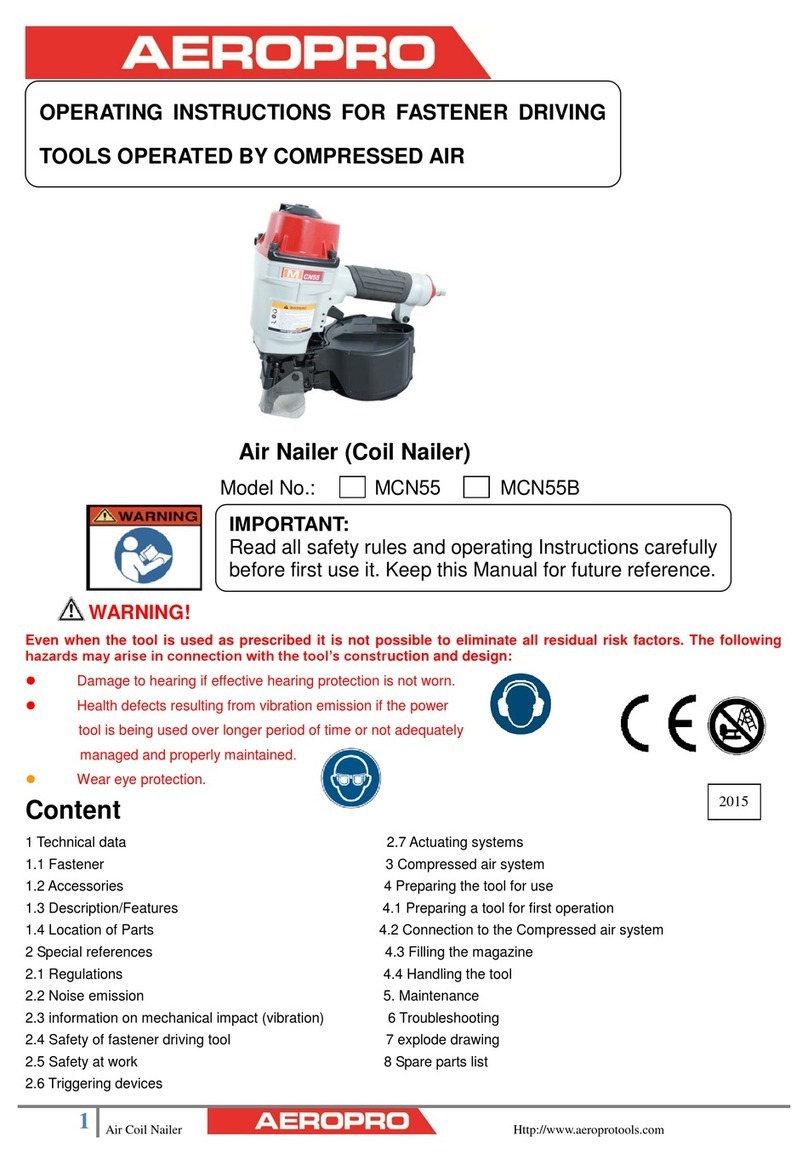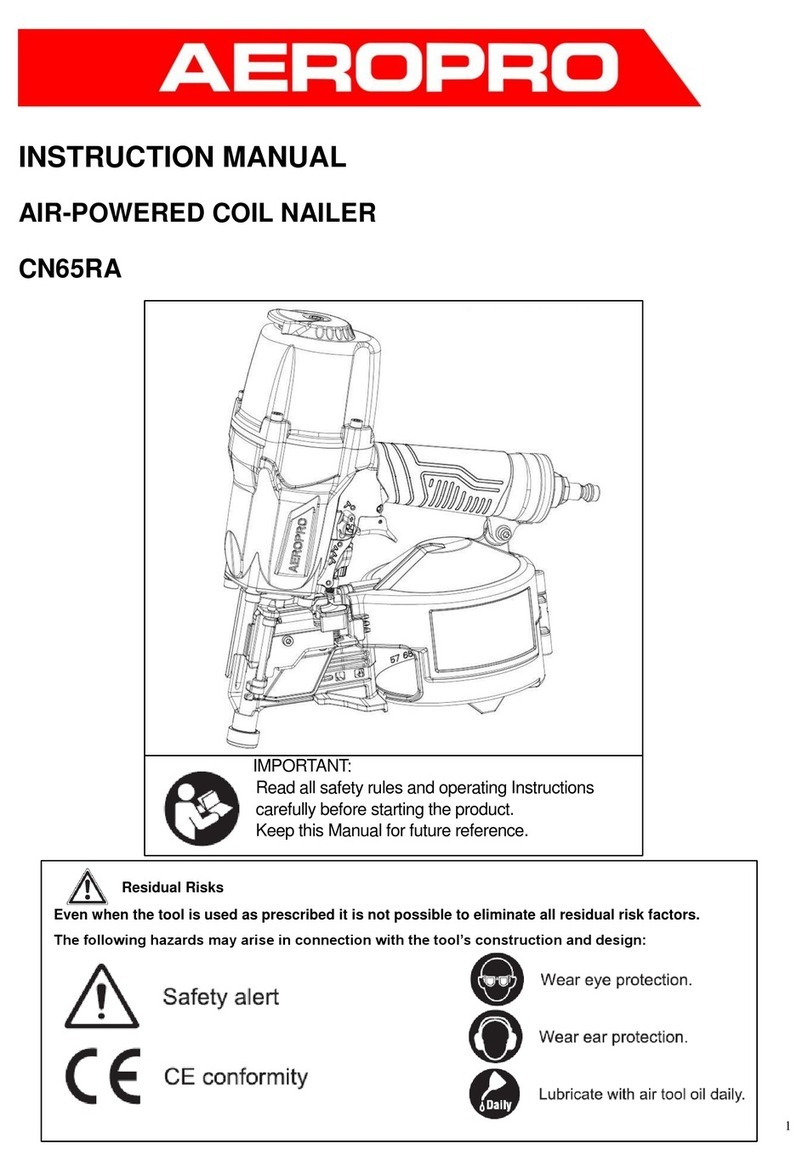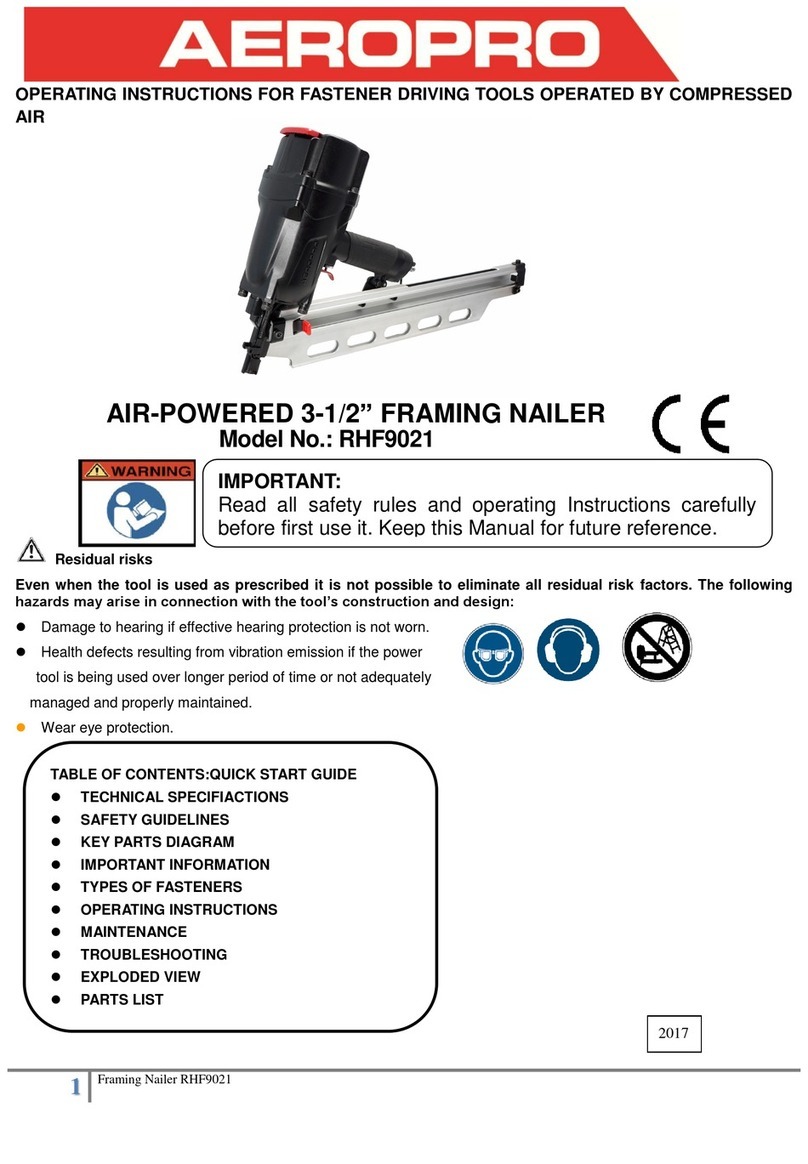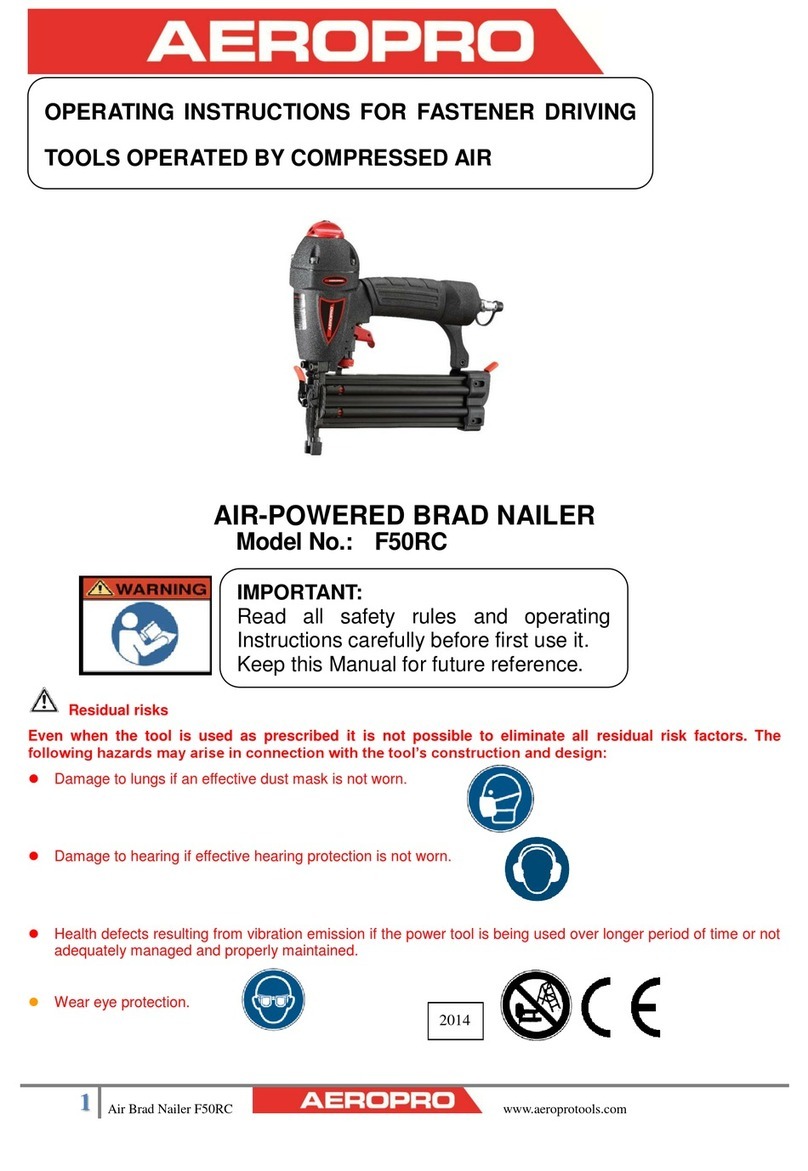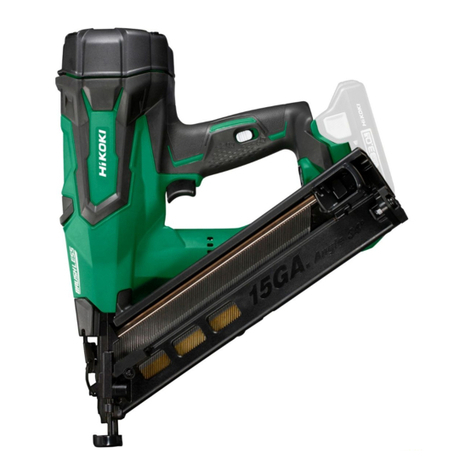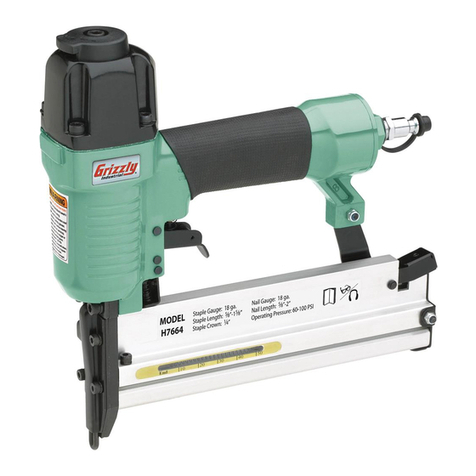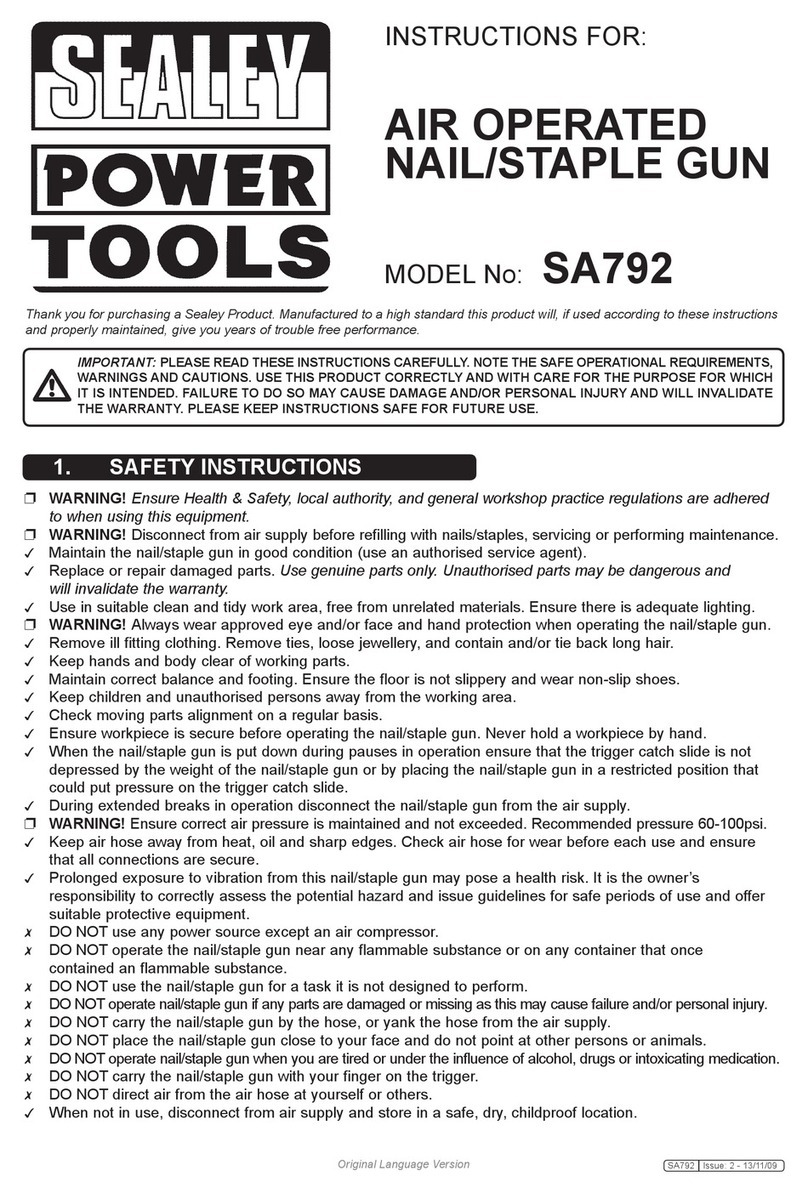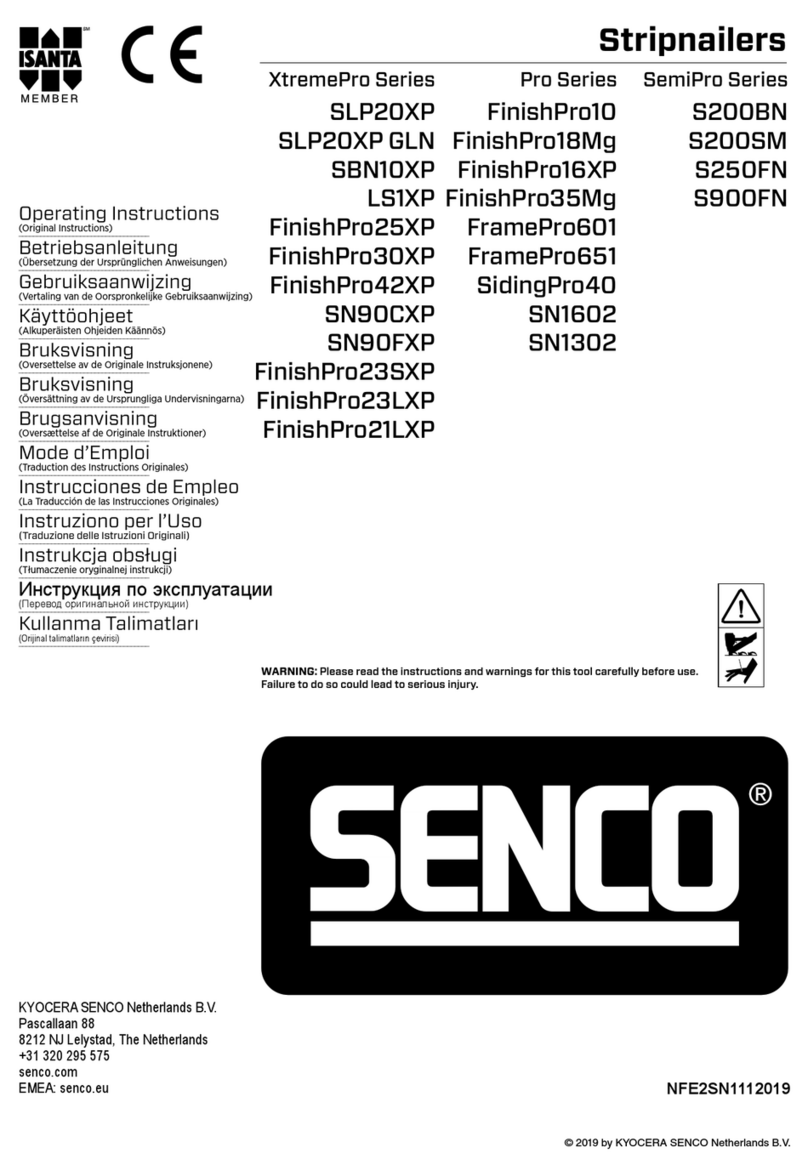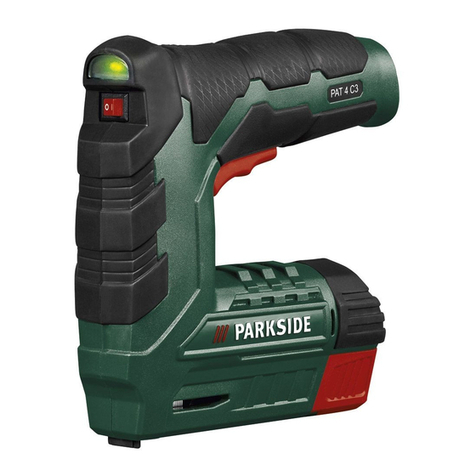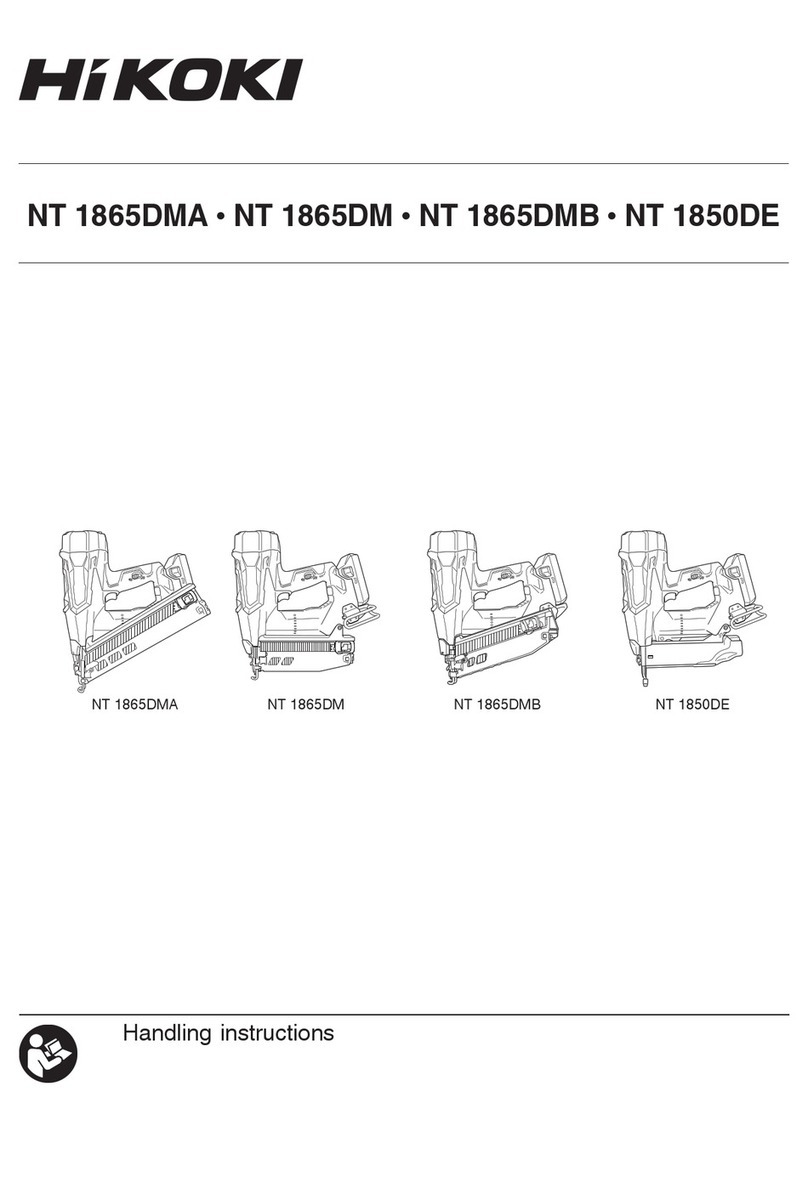Aeropro ACHF9034 User manual

1
Framing Nailer ACHF9034 www.aeroprotools.com
OPERATING INSTRUCTIONS FOR FASTENER DRIVING TOOLS OPERATED BY COMPRESSED
AIR
34 DEGREE AIR-POWERED FRAMING NAILER
Model No.: ACHF9034
Residual risks
Even when the tool is used as prescribed it is not possible to eliminate all residual risk factors. The following
hazards may arise in connection with the tool’s construction and design:
Damage to hearing if effective hearing protection is not worn.
Health defects resulting from vibration emission if the power
tool is being used over longer period of time or not adequately
managed and properly maintained.
Wear eye protection.
2020
IMPORTANT:
Read all safety rules and operating Instructions carefully
before first use it. Keep this Manual for future reference.
TABLE OF CONTENTS:QUICK START GUIDE
TECHNICAL SPECIFIACTIONS
SAFETY GUIDELINES
KEY PARTS DIAGRAM
IMPORTANT INFORMATION
TYPES OF FASTENERS
OPERATING INSTRUCTIONS
MAINTENANCE
TROUBLESHOOTING
EXPLODED VIEW
PARTS LIST
WARRANTY

2
Framing Nailer ACHF9034 www.aeroprotools.com
TECHNICAL SPECIFIACTIONS:
Magazine capacity(QTY.)
2X40pcs
Nailer
Drives Fastener size:Dia.2.87~3.33mm Nail length: 50(2”)-90mm(3-1/2”)
Operating pressure:
70 to110 PSI(4.8 to 7.5 bar)
Maximum pressure:
120PSI (8.3bar)
Air inlet:
3/8”(10mm)
Dimensions:
404X336X118mm(15.90”x13.22”x4.64”)
Weight:
3.54kgs(7.78lb)
SCFM: Standard Cubic feet per minute (the volumetric flow rate of air corrected to standardized conditions of temperature
and pressure).
Environmental Responsibilities
Please recycle unwanted materials instead of disposing of them as waste. All tools, hoses and packaging should be sorted,
taken to the local recycling centre and disposed of in an environmentally safe way.
Safety guidelines
This manual contains information that relates to protecting personal safety and preventing equipment problems.it is very
important to read this manual carefully and understand it thoroughly before using the product.the symbols listed below are
used to indicate this information.
DANGER!
Potential hazard that will result in serious injury or loss of life.
WARRNING!
Potential hazard that could result in serious injury or loss of life.
CAUTION!
Potential hazard that may result in moderate injury or damage to equipment.
Note-The word“note”is used to inform the reader of something he/she needs to know about the tool.
PERSONAL SAFETY
These precautions are intended for the personal safety of the user and others working with the user. please take time to
read and understand them.
DANGER!
Potential hazard that will result in serious injury or loss of life.
Keep children away from the work area. Do not allow children to handle power tools.
Keep air hose away from heat, oil, and sharp edges. Check air hose for wear before each use and ensure that all
connections are proper. Always ensure that the workpiece is firmly secured leaving both hands free to control the
tool.Always ensure that the tool has stopped before putting it down after use, in the interest of safety and to prevent
possible damage to the tool/user.
Keep proper footing at all times in order to ensure correct balance.
Do not use oxygen or any other combustible or bottled gas to power air-powered
tools. Failure to observe this warning can cause explosion and serious personal injury or death.
Use only the compressed air to power the air-powered tools. Use a minimum of 25’(7.6m) of hose
to connect the tools to the compressor. Failure to comply will result in serious injury or loss of life.
Risk of electric shock: Do not expose a compressor to rain. Store it indoors. Disconnect
the compressor from power source before servicing. Compressor must be grounded. Do not use grounding adaptors.
Risk of personal injury: Do not direct compressed air from the air hose toward the user or other personnel.
Risk of inhalation: Never directly inhale the air produced by the compressor.

3
Framing Nailer ACHF9034 www.aeroprotools.com
Risk of bursting: Do not adjust the pressure switch or safety valve for any reason. They have been preset at
the factory for this compressor’s maximum pressure. Tampering with the pressure switch or the safety valve
may cause personal injury or property damage.
Risk of burns: The pump and the manifold generate high temperatures. In order to avoid burns or other
injuries, do not touch the pump, the manifold or the transfer tube while the compressor is running. Allow the
parts to cool down before handling or servicing. Keep children away from the compressor at all times.
Risk of bursting: Make sure the regulator is adjusted so that the compressor outlet
pressure is set lower than the maximum operating pressure of the tool. Before starting
the compressor, pull the ring on the safety valve to make sure the valve moves freely.
Drain water from tank after each use. Do not weld or repair tank. Relieve all pressure in
the hose before removing or attaching accessories.
WARNING!
Potential hazard that could result in serious injury or loss of life.
Do not allow unskilled or untrained individuals to operate the air powered tools.
Do not use the air powered tools for any task other than that it is designed to perform.
Do not use the air tools unless you have been trained to do so. Only a qualified person should use the tool.
Locate the compressor in a well-ventilated area for cooling, and must be a minimum of 12”(31cm) away from the nearest wall.
Protect the air hose and the power cord from damage and puncture. Inspect them for weak or worn spots every week, and replace them if necessary .
Always wear hearing protection when using the air compressor. Failure to do so may result in hearing loss.
Do not carry the compressor while it is running.
Do not operate the compressor if it is not in a stable position.
Do not operate the compressor on a rooftop or in an elevated position that could allow the unit to fall or be tipped over.
Always replace a damaged gauge before operating the unit again.
CAUTION!
Potential hazard that may result in moderate injury or damage to equipment.
Always ensure that the tool has stopped before connecting to the air supply.
Do not wear watches, rings, bracelets, or loose clothing when using any air tool.
Do not overload the tool. Allow the tool to operate at its optimum speed for maximum efficiency.
Do not use a tool that is leaking air, with missing or damaged parts, or that requires repairs. Verify that all screws are
securely tightened.
For optimal safety and tool performance, inspect the tool daily in order to ensure free movement of the trigger, safety
mechanisms, and springs.
Always keep your air tools clean and lubricated. Daily lubrication is essential to avoid internal corrosion and possible failures.
Ensure the floor is not slippery and wear non-slip shoes. Floors should be kept clean can clear.
Always follow all workshop safety rules, regulations, and conditions when using the tools.
Carry the tool by the handle only. Do not carry the tools with a finger on the trigger. Do not carry the tool by the hose,
magazine or any other parts.
Do not use the tool near or below freezing temperatures, as doing so may cause tool failure.
Do not store the tool in a freezing environment to prevent ice formation on the operating valves of the tool, as doing so may cause tool failure.
Handling and storage of oil: Use with adequate ventilation. Avoid contact of oil with eyes, skin, and clothing. Avoid breathing spray or
mist. Store in a tightly closed container in a cool, dry, well-ventilated area free from incompatible substances.
CAUTION!
Potential hazard that may result in moderate injury or damage to equipment.
Disconnect tool from the air supply and turn off the compressor before performing any maintenance, or
changing accessories, when the tool is not in use, when it is being handed to another person, and when

4
Framing Nailer ACHF9034 www.aeroprotools.com
it is left unattended. Failure to comply may result in moderate injury or damage to equipment.
Use safety goggles and ear protection:
Wear safety glasses with side shields when operating the tool/compressor and verify that others in the
work area are also wearing safety glasses.
Requirements and must provide protection from flying particles from the front and the sides.
Air powered tools are loud and the sound can cause hearing damage. Always wear ear protection to
prevent hearing damage and loss. Failure to comply may result in moderate injury.
NOTE: Recycle unwanted materials father than disposing of them as waste. Sort the tools, hoses, and package into
specific categories and take to the local recycling centre or dispose of them in an environmentally safe way.
KEY PARTS DIAGRAM
IMPORTANT INFORMATION
Compatible compressors
GUIDELINES FOR PROPER USE AND OPERATION
Be sure to use a proper air compressor with air powered tools.
General use
This nailer drives nail 50 to 90 mm, If feature a die-cast aluminum housing and a comfortable handle for optimal control
and comfort, even during extended use. It is well balanced for stability, and ergonomically designed with a longer handle
for ease of operation. It also features a hardened driver blade for longer life, and economical air consumption with low
noise. This air powered nailer is specifically designed for professional work.
Air system
Always use clean, dry, regulated, compressed air at 4.8 to 7.5bar (70 to 110psi).
Do not exceed the maximum or minimum pressures. Operating the tool at the wrong pressure(too low or too high) will
cause excessive noise or rapid wear of tool.
WARNING!
Potential hazard that could result in serious injury or loss of life.
Keep hands and other parts of the body away from the tools discharge and working areas when connecting the
air supply. Failure to comply could lead to serious injury or loss of life.
No.
Description
No.
Description
No.
Description
1
Magazine
4
Trigger
7
Adjuster
2
Gun Body
5
Air inlet plug
8
3
Cylinder Cap
6
Change Knob
9
3
4
5
1
2
6
7

5
Framing Nailer ACHF9034 www.aeroprotools.com
It is recommended that a filter-regulator-lubricator is used and located as close to the tool as possible.
If a filter-regulator-lubricator in not installed, place up to 6 drops of compressor oil into the inlet plug before each use.
If a filter-regulator-lubricator is installed, keep the air filter clean. Adirty filter will reduce the air pressure to the tool,
which will cause reduction in power, efficiency, and general performance.
For optimal performance, install a quick connector to the tool and a quick coupler on the hose, if applicable.
Verify that all of the connections in the air supply system are sealed in order to prevent air from leaking.
NO.
Description
NO.
Description
NO.
Description
1
AEROPRO Air powered Framing nailer
4
Air Hose
7
Filter
2
Quick connector
5
Lubricator
8
Cut-off valve
3
Quick coupler
6
Regulator(0 to 8.3 Bar)
9
Air compressor
WARNING!
Potential hazard that could result in serious injury or loss of life.
Do not use the tool if it is not in proper working order.
Do not use oxygen,carbon dioxide or any other combustible, or bottled gas to power this tool.
Do not use this tool in the presence of any flammable liquids or gases.
Keep hands and other parts of the body away from the firing head during use.
Do not point the tool towards the operator or other people.
Never attempt to clear a jammed fastener while the air hose is connected.
Do not drive a fastener on top of an existing fastener. Failure to comply could lead to serious injury or loss of life.
TYPES OF FASTENERS
Please see the TECHNICAL SPECIFIACTIONS.
WARNING!
Potential hazard that could result in serious injury or loss of life.
The use of any other types of fasteners will cause the tool to jam. Failure to comply could lead to serious injury or loss of life.
OPERATING INSTRUCTIONS
4.1 Preparing a tool for first time operation
Please Read and observe these Operating Instruction before using the tool. Basic safety measures should always be strictly followed
to protect against damage to the equipment and personal injury to the user or other people working in the vicinity of operation.
WARNING!
Potential hazard that could result in serious injury or loss of life.
NEVER point tool at yourself or others in work area.
Keep fingers AWAY from trigger when not driving nails to avoid accidental firing.
Choice of triggering method is important.
Please read and understand “Methods of Operation"below.
Before starting work, check the nailing operation switching device.
This nailer includes a nailing operation switching device.

6
Framing Nailer ACHF9034 www.aeroprotools.com
Before starting work,make sure that the switching device is properly set.
If the switching device is not set properly, the nailer will not operate correctly.
Never place your hands or feet closer than 8 inches (200 mm) from firing head when using.
Do not drive nails on the top of other nails or with Nailer at too steep of an angle; nails can ricochet and hurt someone.
Do not drive nails into thin boards or near corners and edges of workpiece. Nails can be driven through or away from
workpiece and hit someone.
Never drive nails from both sides of a wall at the same time. Nails can be driven into and through the wall and hit a
person on the opposite side.
Never use Nailer which is defective or operating abnormally.
Do not use Nailer as hammer.
Disconnect air hose from Nailer when:
1) it is not in use; 2)leaving work area; 3)moving it to another location; 4)handing it to another person; and
5) changing switching device.
This nailer is equipped with a nailer operation switching device.
Use SINGLE SEQUENTIALACTUATION MECHANISM or CONTACTACTUATION MECHANISM in accordance with the
work to be performed.
Explanation of the various nailing operations:
SINGLE SEQUENTIAL ACTUATION MECHANISM: First, press the push lever against the workpiece; next, pull the
trigger to drive the nail. After nailing once,nailing will not be possible again until the trigger is released and pressed
again.
CONTACT ACTUATION MECHANISM: First, press the push lever against the workpiece; next, pull the trigger to drive
the nail. Or, pull the trigger; next, press the push lever against the workpiece to drive the nail. If the trigger is held
back, a nail will be driven each time the push lever is pressed against the workpiece.
METHODS OF OPERATION
This Nailer is equipped with the push lever and does not operate unless the push lever is depressed (upward
position).There are two methods of operation to drive nails with this Nailer. They are:
1. Intermittent operation (Trigger tire);
2. Continuous operation(Push lever fire).Intermittent operation(Trigger fire) use the SINGLE SEQUENTIAL ACTUATION
MECHANISM setting.
For intermittent operation, set the switching device to the upward position completely (i.e.Set to SINGLE SEQUENTIAL
ACTUATION MECHANISM.)
To avoid double firing or accidental firing due to recoil.
1)Set the switching device to SINGLESEQUENTIALACTUATION MECHANISM.
2)Pull the trigger rapidly and firmly.
①Set the switching device to the upward position (to set to SINGLE SEQUENTIALACTUATION MECHANISM).

7
Framing Nailer ACHF9034 www.aeroprotools.com
(Set the switching device to the upward position completely as shown in the diagram. Otherwise, it will be set to
CONTACT ACTUATION MECHANISM.)
②Position the nail outlet on the workpiece with finger of the trigger.
③Depress the push lever firmly until it is completely depressed.
④Pull the trigger to drive a nail.
⑤Remove finger from the trigger
To continue nailing in a separate location, move the nailer along the wood, repeating steps ②-⑤as required.
WARNING!
Potential hazard that could result in serious injury or loss of life.
A nail will fire each time the trigger is depressed as long as the push lever remains depressed.
(2)Continuous operation(Push lever fire) Using CONTACT ACTUATION MECHANISM
WARNING!
Potential hazard that could result in serious injury or loss of life.
To avoid double firing or accidental firing due to recoil.
1) Do not press the nailer against the wood with excessive force.
2) Separate the nailer from the wood as it recoils after nailing.
①Set the switching device to the downward position (to set to CONTACT ACTUATION MECHANISM). (Set the switching
device to the downward position completely as shown in the diagram. Otherwise, it will not operate properly.)
②Pull the trigger with the Nailer off the workpiece.
③Depress the push lever against the workpiece to drive a nail.
④Move the Nailer along the workpiece with a bouncing motion. Each depression of the push lever will drive a nail. As
soon as the desired number of nails have been driven, remove finger from the trigger.
WARNING!
Potential hazard that could result in serious injury or loss of life.
Keep your finger of the rigger except during fastening operation, because serious injury could result if the push lever
accidentally contacts you or others in work area.
Keep hands and body away from the discharge area. This nailer may bounce from the recoil of driving a fastener

8
Framing Nailer ACHF9034 www.aeroprotools.com
and unwanted subsequent fastener may be driven, possibly causing injury.
Some types of loaded nails can spark out of the muzzle during a nail driving operation. Exericise Caution!
The SINGLE SEQUENTIALACTUATION MECHANISM is for use where precision fastener placement is desired.
The SINGLE SEQUENTIAL ACTUATION MECHANISM may reduce the possibility of bodily injury to you or others in the
work area compared to the CONTACT ACTUATION MECHANISM. This is because it is less likely to drive an unwanted
nail if you keep the trigger pulled and accidentally bump the push lever against yourself or others.
The SINGLE SEQUENTIAL ACTUATION MECHANISM may also reduce the speed of operation compared to the
CONTACT ACTUATION MECHANISM. The SINGLE SEQUENTIAL ACTUATION MECHANISM is recommended to
inexperienced users.
NOTE
If all warnings and instructions are followed, safe operation is possible with all two systems: SINGLE SEQUENTIAL
ACTUATION MECHANISM and CONTACTACTUATION MECHANISM.
Always handle nails and package carefully. If nails are dropped, collating plastic may be broken.
After nailing: 1)disconnect air hose from the Nailer; 2)remove all nails from the Nailer;
3)supply 5-10 drops of pneumatic tool lubricant into the air plug on the Nailer;
4)open the petcock on the air compressor tank to drain any moisture.
ADJUSTING THE NAILING DEPTH
To assure that each nail penetrates to the same depth, be sure that:
1) The air pressure to the Nailer remains constant (regulator is installed and working properly,and
2) The Nailer is always held firmly against the workpiece. If nails are driven too deep or shallow into the workplece,
adjust the nailing in the following order.
①DISCONNECT AIR HOSE FROM NAILER.
②If nails are driven too deep, turn the adjuster to the shallow side.
If nails are driven too shallow, turn the adjuster to the deep side.
③Stop turning the adjuster when a suitable position is reached for a nailing test.
④Connect the air hose. ALWAYS WEAR EYE PROTECTOR. Perform a nailing test.
⑤DISCONNECT AIR HOSE FROM NAILER.
⑥Choose a suitable position for the adjuster.
4.2 Connection to the compressed air system
Ensure that the pressure supplied by the compressed air system does not exceed the maximum allowable pressure of
the fastener driving tool. Set the air pressure initially to the lower value of the recommended allowable pressure (see
TECHNICAL DATA). Empty the magazine to prevent a fastener from being ejected at the next stage of work in the event
that internal parts of the fastener driving tool are not in the starting position following maintenance and repair work or

9
Framing Nailer ACHF9034 www.aeroprotools.com
transportation. Connect the fastener driving tool to the compressed air supply using suitable pressure hose equipped
with quick-action connectors. Check for proper functioning by applying the muzzle of the fastener driving tool to a piece
of wood or wooden material and actuating the trigger once or twice.
4.3Filling the magazine
Only those fasteners specified under TECHNICAL DATA (see 1.1) may be used
When filling the magazine, hold the tool so that the muzzle is not pointing towards the operator or any other person or animals.
4.4 Handling the tool
Pay attention to 2-Special Reference-of these operating instructions.
Having checked that the fastener driving tool is functioning correctly, apply the tool to a work piece and actuate the trigger.
Check whether the fastener has been driven into the work piece in accordance with the requirements.
- if the fastener is protruding, increase the air pressure in increments of 0.6 bar, checking the result after each new adjustment;
- if the fastener is driven into an excessive depth reduce the air pressure I increments of 0.6 bar until the result is satisfactory.
You should endeavor in any event to work with the lowest possible air pressure. This will give you three significant advantages;
1.energy will be saved, 2.less noise will be produced, 3.a reduction in fastener driving tool wear will be achieved.
Avoid triggering the fastener driving tool if the magazine is empty.
Any defective or improperly functioning fastener driving tool must immediately be disconnected from the compressed air
supply and passed to a specialist for inspection.
In the event of longer breaks in work or at the end of the working shift, disconnect the tool from the compressed air supply
and it is recommended to empty the magazine.
The compressed air connectors of the fastener driving tool and the hoses should be protected against contamination, the
ingress of coarse dust chips, sand etc, will result in leaks and damage to the fastener driving tool and the couplings.
DANGER! Potential hazard that could result in serious injury or loss of life
Disconnect the tool from the compressed air source before loading fasteners.
Do not point the tool towards the operator or other people while changing fasteners.
Do not hold the tool with the trigger depressed while changing the fasteners. Failure to comply will lead to serious
injury or loss of life.
WARNING! Potential hazard that could result in serious injury or loss of life.
CAUTION!
Potential hazard that may result in moderate injury or damage to equipment.
Operate the tool with the utmost care when connected with the air compressor.
Failure to comply may result in moderate injury or damage to equipment.
Clearing a jammed fastener
Disconnect the tool from the air supply line.
Remove the fasteners that are stored in the tool’s magazine.
WARNING!
Potential hazard that could result in serious injury or loss of life.
Disconnect the magazine from the tool and remove the non-jammed fasteners from the tool before clearing
a jammed fastener. The fasteners are under pressure and failure to comply will cause them to be fired out of
the tool causing serious injury.
Do not point the tool towards the operator or other people. Serious personal injury could result if these
instructions are not followed.
Use pliers or any appropriate tool to remove the jammed fastener.
Reload the fasteners into the tool magazine.
Reconnect the air line to the tool's air inlet
Test fire 3 to 5 fasteners into a piece of scrap wood in order to ensure proper operation

10
Framing Nailer ACHF9034 www.aeroprotools.com
5. Maintenance
Disconnect the tool from the compressor before adjusting, clearing jams, servicing &maintenance, relocating and during non operation.
Regular lubrication, if your tool without using the in-liner automatic oilier, place 2 or 6 drops of pneumatic tool oil into the air inlet before
each work day or after 2 hours of continuous use depending in the characteristic of workpiece or type of fasteners.
Air-operated tools must be inspected periodically, and worn or broken parts must be replaced to keep the tool operating safely and
efficiently. Check and change all worn or damaged O-ring, Seals, etc. Tighten all the screws and caps to avoid personal injury. This
should be done by an expert. Make regular inspection for free movement of trigger, Spring and safety mechanism to assure safe
system is complete and functional: no loose and missing parts, no building or stocking parts. Keep magazine and nose of tool clean
and free of any dirt lint or abrasive particles. When temperatures are below freezing, tools should be kept warm by any convenient,
safe method.
6. Troubleshooting (See Table 1)
The following chart lists common operating system issues and solutions.please read it carefully and follow all instructions closely.
DANGER! Potential hazard that could result in serious injury or loss of life.
If any of the following symptoms appear while the tool is in use,turn it off and disconnect it from the air supply
immediately. Failure to comply will lead to serious injury or loss of life.
Disconnect the tool from the air supply before making any adjustments.
Repairs must be performed by a qualified service technician only.
SYMPTOM
PROBLEM
SOLUTIONS
Air leak near top of
tool or in trigger area
1.O-ring in trigger valve are damage.
2.Trigger valve head are damage.
3.Trigger valve stem ,seal or O-ring are damaged.
1.Check and replace O-ring.
2.Check and replace.
3.Check and replace trigger valve stem, seal or O-ring
Air leak near bottom
of tool.
1. Loose screws.
2. Worn or damaged O-rings or bumper.
1. Tighten screws.
2. Check and replace O-rings or bumper.
Air leak between
body and cylinder
cap.
1. Loose screws.
2. Worn or damaged O-rings or seals.
1. Tighten screw.
2. Check and replace O-rings or bumper.
Blade driving
fastener too deep.
1. Worn bumper.
2. Air pressure is too high.
1. Replace bumper.
2.Adjust the air pressure.
Tool does not
operate well: can not
drive fastener or
operate sluggishly.
1. Inadequate air supply.
2. Inadequate lubrication.
3. Worn or damaged O-rings or seals.
4. Exhaust port in cylinder head is blocked.
1. Verify adequate air supply.
2. Place 2 or 6 drops of oil into air inlet.
3. Check and replace O-rings or seal.
4. Replace damaged internal parts.
Tool skips fasteners.
1. Worn bumper or damaged spring.
2. Dirt in front plate.
3. Dirt or damage prevents fasteners from
moving freely in magazine.
4. Worn or dry O-ring on piston or lack of lubrication.
5. Cylinder cover seal leaking.
1. Repalce bumper or pusher spring.
2. Clean drive channel on front plate.
3. Magazine needs to be cleaned.
4. O-ring need to be replaced.And lubricate.
5. Replace Sealing washer.
Tool jams.
1. Incorrect or damaged fasteners.
2. Damaged or worn driver guide.
3. Magazine or nose screw loose.
4. Magazine is dirty.
1. Change and use correct fastener.
2. Check and replace the driver.
3. Tighten the magazine.
4. Clean the magazine.
Table 1

11
Framing Nailer ACHF9034 www.aeroprotools.com
EXPLODED VIEW

12
Framing Nailer ACHF9034 www.aeroprotools.com
PARTS LIST
No.
Description
Qty.
No.
Description
Qty.
No.
Description
Qty.
1
Bolt M5X14
4
32
Nut M5
1
63
Change Knob
1
2
Spring Washer 5
4
33
Pushing Lever
1
64
Roll Pin 3x10
1
3
Air Deflector
1
34
Retaining Ring
2
65
Grip Bubber
1
4
Bolt M6X30
4
35
Adjuster
1
66
Gasket
1
5
Spring Washer 6
4
36
Adjuster Plate
1
67
Cap
1
6
Cylinder Cover
1
37
Pushing Lever
1
68
Bolt M5X20
3
7
Cylinder Washer
1
38
Pushing Lever Spring
1
69
Air Plug
1
8
Exhaust Valve Rubber
1
39
Pushing Lever Guide
1
70
Air Plug Case
1
9
Compressed Spring
1
40
O-Ring 14x1.8
1
71
Ribbon Spring
1
10
O-ring 48.7x2.65
1
41
Valve Seat
1
72
Spring Core
1
11
O-ring 63x2.65
1
42
O-Ring 16x1.6
1
73
Needle Roll 4x18
1
12
Head Valve Assembly
1
43
Valve Bushing
1
74
Spring Pin
1
13
O-ring 50x3.55
1
44
O-Ring 6.1x1.8
1
75
Nail Feeder Seat
1
14
Main Piston
1
45
O-Ring 6.4x2
1
76
Compressed Spring
1
15
Sealing Washer
1
46
O-Ring 9x1.8
1
77
Nail Feeder
1
16
O-ring 62.5x3.1
1
47
Plunger Spring
1
78
Roll Pin 4x30
1
17
Cylinder
1
48
Plunger
1
79
Magazine Cover
1
18
Sealing Washer
1
49
O-Ring 2.4x1.6
2
80
Nut M6
4
19
O-ring 95x2.65
1
50
O-Ring 20x1.8
1
81
Handle Arm
1
20
Bumper Plate
1
51
Plunger Seat
1
82
Magazine
1
21
Piston Bumper
1
52
Compressed Spring
1
83
Nail Rail
1
22
Change Level
1
53
Roll Pin
1
84
Roll Pin 3x8
1
23
O-ring 1.7x2
1
54
Roll Pin 3x28
1
85
Bolt M6X12
3
24
Gun Body
1
55
Roll Pin 3x30
1
86
Nail Stopper
1
25
O-ring 62x1.8
1
56
Roll Pin 3x22
1
87
Bushing
1
26
Nose
1
57
Bolt M6X22
1
101
Wrench M5
1
27
Nose Rubber
2
58
Trigger Arm
1
102
Wrench M6
1
28
Spring Washer 8
4
59
Trigger
1
103
Wrench M8
1
29
Bolt M8x30
4
60
Roll Pin 2.5x16
1
104
Oiler
1
30
Washer
1
61
Steel Ball
1
105
goggles
1
31
Pushing Lever Cover
1
62
Compressed Spring
1
106
Manual
1
Note:
If you need spare parts of this model, pls feel free to contact us or the distributor where you bought this tool.
Thanks!
Table of contents
Other Aeropro Nail Gun manuals
Popular Nail Gun manuals by other brands

Hitachi
Hitachi nv90ag Instruction and safety manual
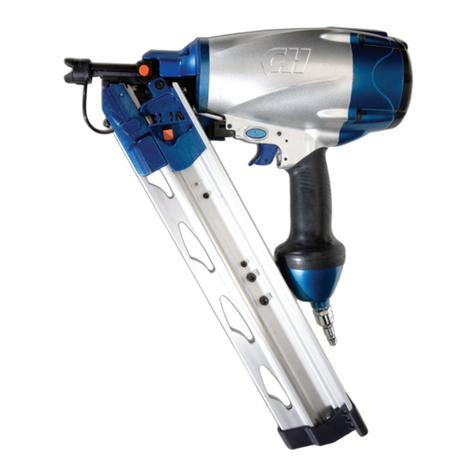
Campbell Hausfeld
Campbell Hausfeld IN727700AV Operating instructions and parts manual

Porter-Cable
Porter-Cable FR350 instruction manual
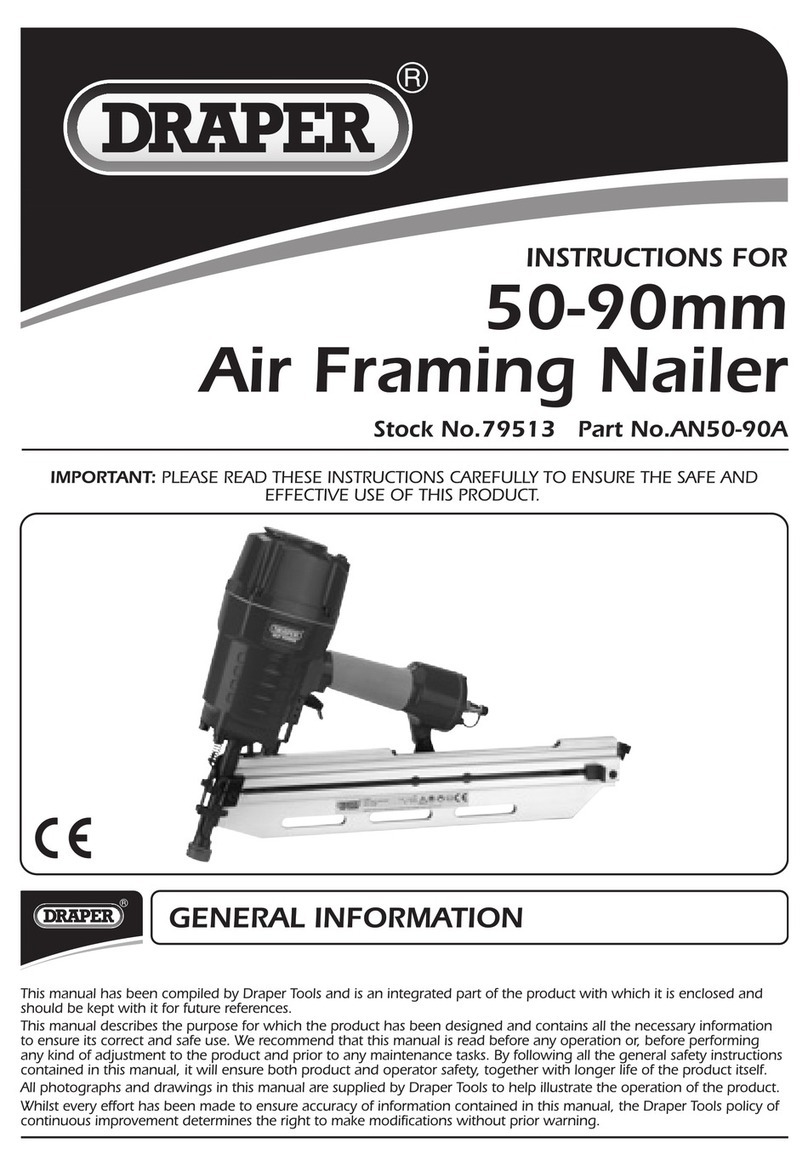
Draper
Draper AN50-9*0A instructions
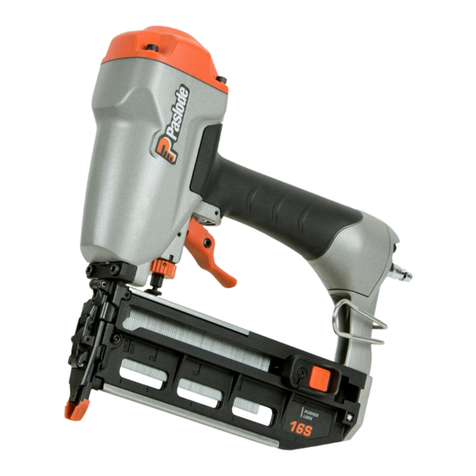
Paslode
Paslode T250S-F16P Operating manual and tool schematic
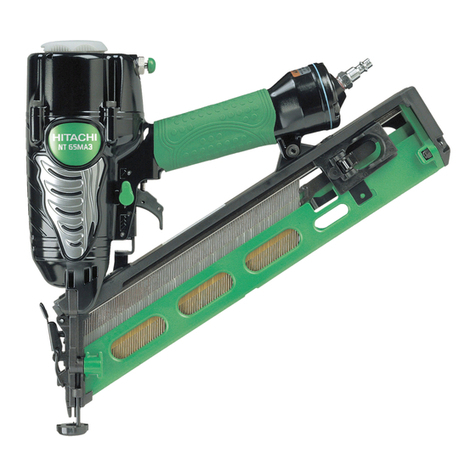
Hitachi
Hitachi NT 65MA2 instruction manual

Kyocera
Kyocera TJEP ST-15/50 GAS Safety and operation instructions

Milwaukee
Milwaukee C12 PN Original instructions
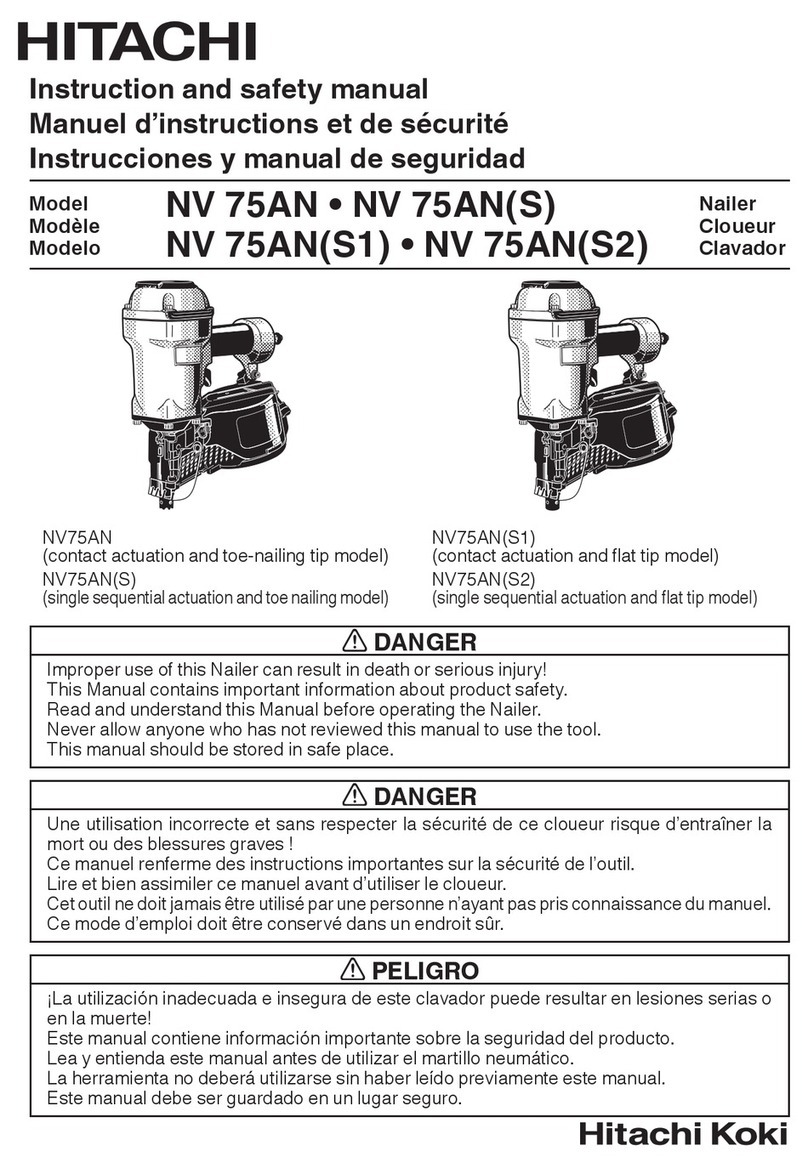
Hitachi
Hitachi NV 75AN Instruction and safety manual
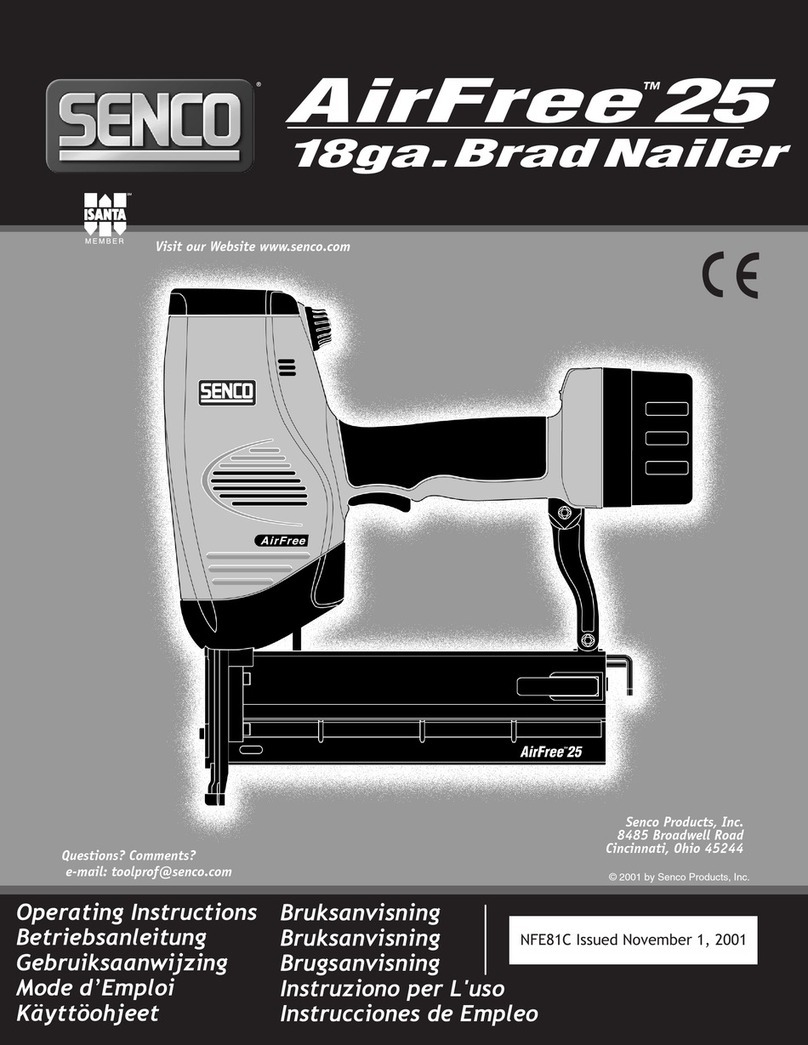
Senco
Senco AirFree 25 operating instructions
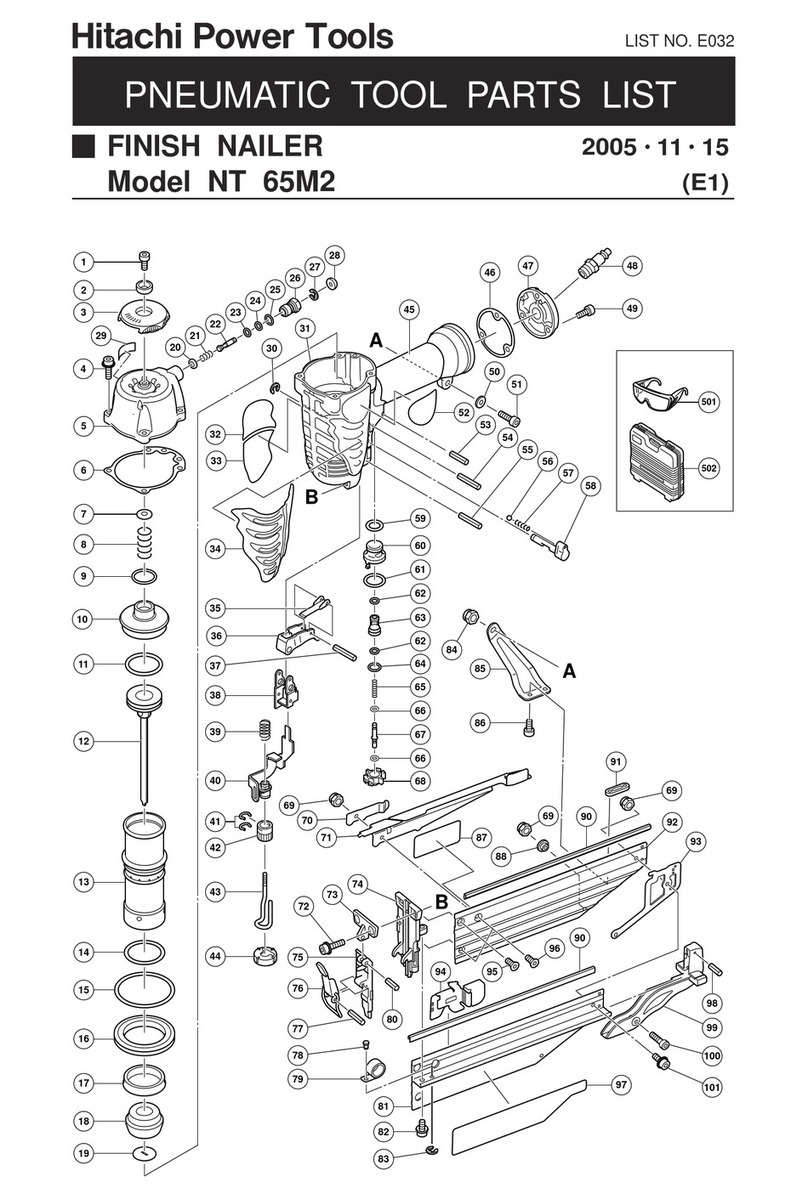
Hitachi
Hitachi NT65M2 - to 2-1 16 Gauge Finish Nailer parts list

Paslode
Paslode FN2265 operating instructions
